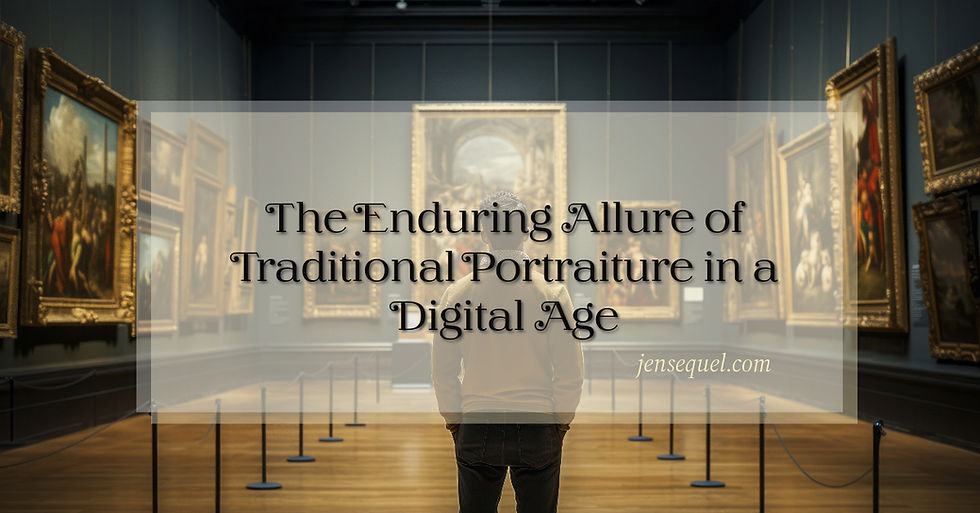Portraits in Ancient Art: Capturing the Essence of Humanity
- Jen Sequel
- Aug 5, 2024
- 3 min read

Portraiture is one of the most compelling genres in the history of art. It has been used for millennia to capture the essence, likeness, and status of individuals. From the earliest civilizations to the classical periods of Greece and Rome, portraits have served as more than mere representations—they've been windows into the souls and societies of ancient peoples.
Ancient Egypt: The Eternal Life

In ancient Egypt, portraits were integral to the culture's emphasis on the afterlife. Pharaohs, queens, and nobles were immortalized in statues, busts, and wall reliefs designed to last for eternity. The most iconic of these is the funerary mask of Tutankhamun, a stunning golden visage that captures the youthful king's features in idealized form. Egyptian portraits often followed strict conventions, with frontal poses, almond-shaped eyes, and a serene, almost divine expression that conveyed power and tranquility.
Portraits in Egypt were not just for commemoration but also for religious purposes. They were believed to house the ka, or spirit, of the deceased, ensuring their presence in the afterlife. This belief in the spiritual power of the portrait is reflected in the meticulous craftsmanship and enduring materials chosen by Egyptian artists.
Mesopotamia: Kings and Gods

Mesopotamian portraits, while less prevalent than Egyptian ones, also held significant cultural importance. The Akkadian ruler Sargon of Akkad and the Assyrian kings like Ashurbanipal were often depicted in statuary and reliefs. These portraits were less idealized than their Egyptian counterparts, showcasing a more realistic approach to human features. The limestone bust of Sargon, for example, reveals a strong, determined face, emphasizing his authority and divine right to rule.
In Mesopotamia, portraits served not only to glorify rulers but also to bridge the human and divine realms. Many statues and reliefs show kings in the company of gods, symbolizing their role as intermediaries between the heavens and earth. This connection to the divine was a crucial aspect of Mesopotamian kingship, reinforcing their power and legitimacy.
Ancient Greece: The Ideal and the Individual

Greek portraiture underwent significant evolution, reflecting broader changes in Greek society and art. Early Greek portraits were heavily idealized, focusing on capturing the perfect human form. The kouros and kore statues of the Archaic period, with their stylized features and rigid postures, are prime examples of this approach.
The Classical period brought a shift towards naturalism and individualism. Artists like Phidias and Praxiteles began to create more lifelike and dynamic representations. The portrait busts of philosophers, playwrights, and politicians from this era show a keen interest in capturing not just physical likeness but also the character and intellect of the subject. The famous bust of Pericles, with his thoughtful gaze and dignified bearing, exemplifies this trend.
By the Hellenistic period, Greek portraiture reached new heights of realism and emotional depth. The sculptures of this era, such as the busts of Alexander the Great, depict a range of expressions and psychological states, reflecting the complexities of the human condition.
Ancient Rome: Realism and Power

Roman portraiture was profoundly influenced by Greek art but developed its own distinct characteristics. The Romans placed a high value on realism and individuality, often depicting their subjects with unflinching honesty. This is evident in the veristic portraits of the Roman Republic, which show elderly patricians with all their wrinkles and blemishes, emphasizing wisdom and experience.
Imperial portraiture in Rome took on a propagandistic role. Emperors like Augustus and Hadrian were portrayed in an idealized manner, emphasizing their youth, vigor, and divine favor. These portraits were widely disseminated throughout the empire, serving as powerful tools of political propaganda. The statue of Augustus of Prima Porta, with its idealized features and commanding pose, exemplifies the blend of realism and idealism that characterized Roman imperial portraiture.
Legacy and Influence
The portraits of ancient civilizations have left a lasting legacy on the art world. They not only provide a visual record of historical figures but also offer insights into the values, beliefs, and aesthetics of their cultures. These ancient artworks continue to inspire modern artists, who look to the past for techniques, themes, and inspiration.
In conclusion, portraits in ancient art are much more than mere likenesses. They are rich, complex expressions of identity, power, and spirituality. Whether in the eternal calm of an Egyptian pharaoh, the divine right of a Mesopotamian king, the idealized beauty of a Greek philosopher, or the unvarnished realism of a Roman patrician, these ancient portraits capture the essence of humanity in all its varied forms.





Comments